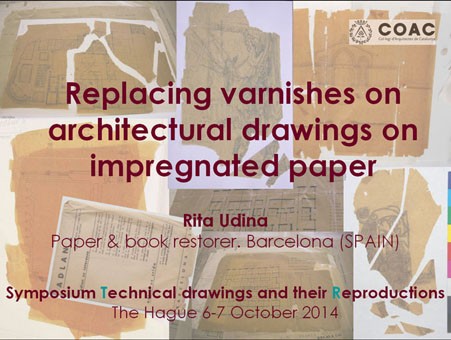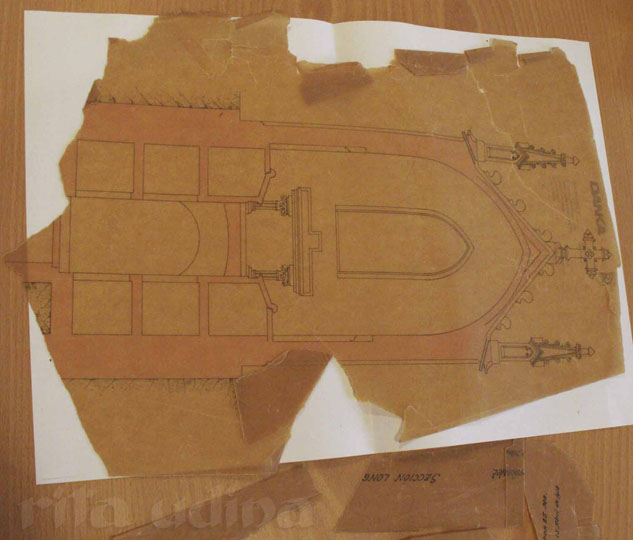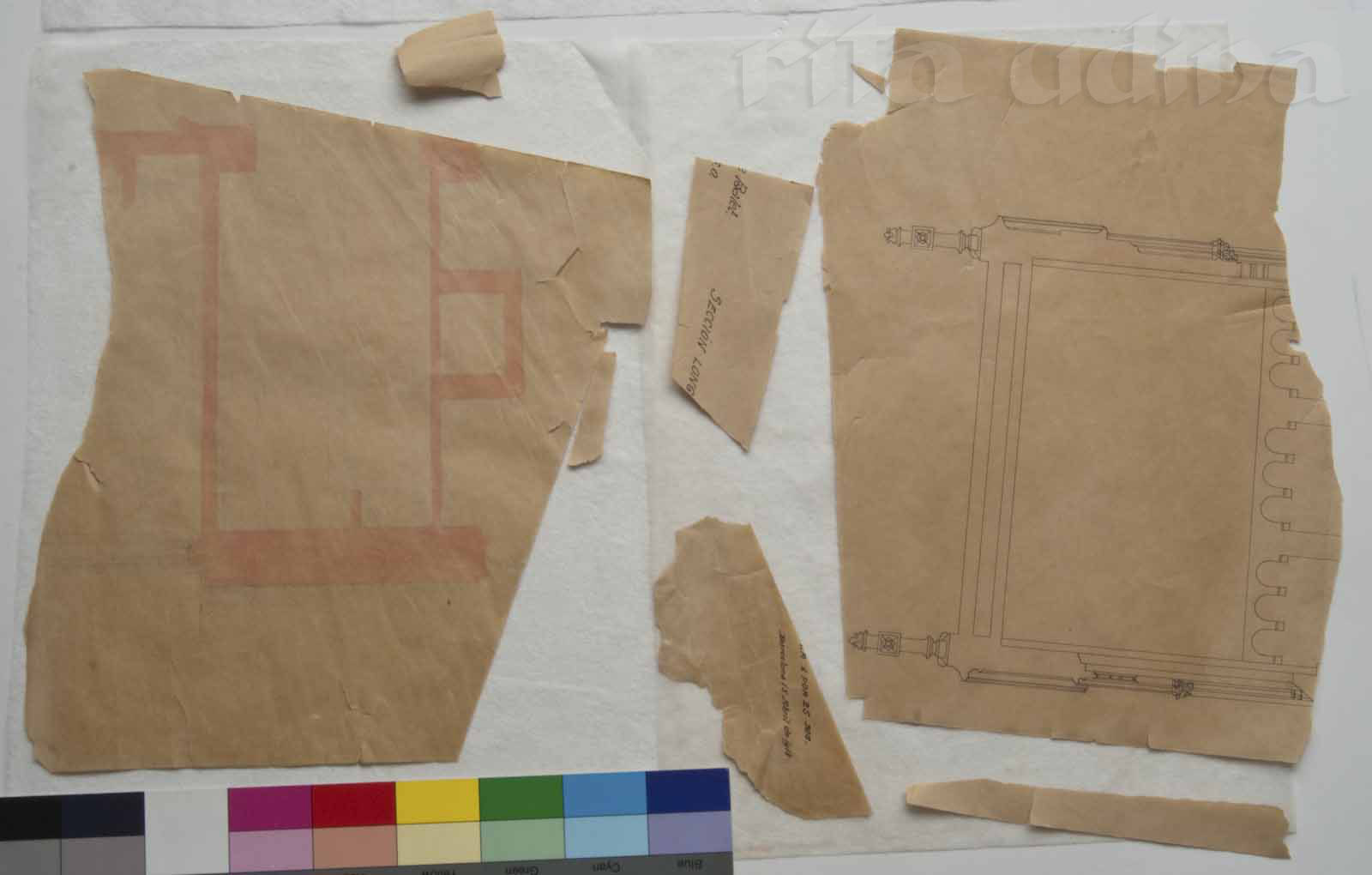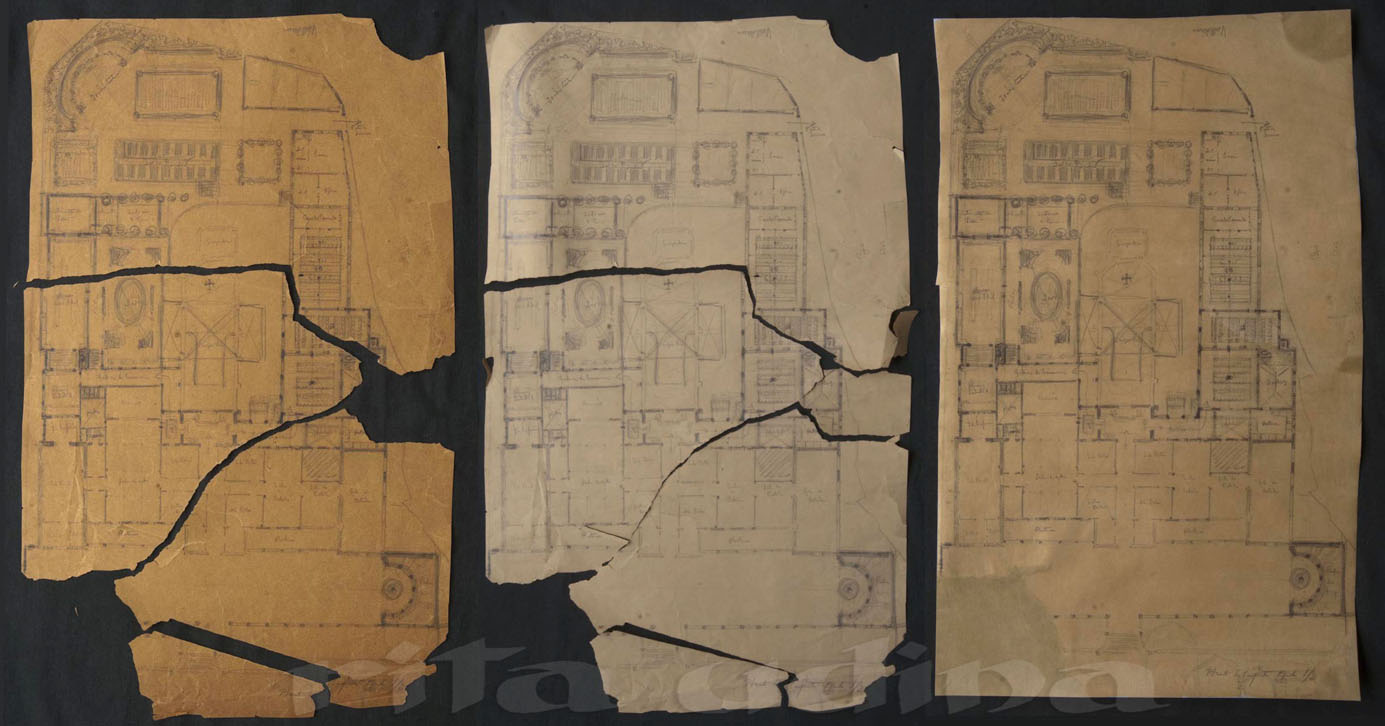New conservation methodolgy to retrieve lost flexibility to brittle tracing paper
Technical drawings from CoAC with severe brittleness
This post shows the experience after the restoration of many of the architectural drawings from the Association of Architects of Catalonia (CoAC) and focuses on impregnated paper. It was presented on the context of the Symposium Technical Drawings and their Reproductions entitled “Replacement of varnishes/oils on impregnated paper architectural drawings” (The Hague, october 2014).
Tracing paper -so usual among technical drawings- have in common their transparency, but there are significant differences in the process to make them. Therefore both their chemical and physical properties, as well as their behaviour shall be very diverse. Impregnated paper has poor mechanical strength due to the oxidation caused by the varnish that was applied to provide translucency. The most commonly used varnishes have inherent oxidizing degradation that causes brittleness and acidification. It must be reminded that oils do not evaporate by a physical process, like water, but a chemical one (oxidation). But varnishes also prevent cellulose from moisturizing normally (waterproofing) and confer the paper its particular fragility and stiffness. Shellac specifically provides the paper from the characteristic fragility of the varnish.
This video shows how difficult it is to make any wet treatment on an impregnated tracing paper (unless the varnish is removed):
Architectural drawing on impregnated tracing paper, ink and hand coloured. It is very fragmented due to the severe brittleness. It is not clear whether it is a single drawing fragmented or maybe more than one. CoAC.
Fragility may be such that it completely impedes manipulation, since any ordinary and careful handling causes cracks or tears. Loss of flexibility causes sharp cuts on the folds (left image) and tears on creases (right). Tears and creases can be even more visible than the drawing lines.
Two details of the same architectural drawing on impregnated tracing paper. Brittleness involves that folds and creases become whitish, and might be more visible than the drawing lines. Any fold or crease has high possibilities of becoming a tear. Architectural drawing on impregnated tracing paper, ink and hand coloured. CoAC.
Conservation aims to reach these goals:
- Stop the oxidation, or even revert some of its consequent acidification.
- Retrieve lost flexibility.
- Strictly maintain the scale (for the case of plans/maps).
Reinforcement by addition of paper layers compromises a transparency that shouldn’t be modified, that’s why retrieving the lost flexibility is so important, as the less brittle is the original paper, the thinner paper layers are needed to reinforce it. Discolouration is not considered a damage in itself, as in general it allows a correct lecture of the document, and doesn’t involve chemical damage (yet it is the visible effect of acidification).
TREATMENT:
Varnish removal
This would avoid further oxidation damage and diminish some discolouration. The varnish is removed by solvent (varying each case, depending on the oil or varnish to be removed). After that, the paper becomes opaque, but then efficient aqueous treatments are possible, if suitable.
The same document after varnish removal becomes opaque. It is worth noticing that the left fragment (on the back side) shows only the watercolour, whereas at the right one, front side, only ink black lines are visible, but not watercolour. The loss of transparency involves loosing the layers effect it had before, when lines and hand-colour were visible simultaneously on both sides. Architectural drawing on impregnated tracing paper, ink and hand coloured. CoAC.
Reinforcement
Lining, when needed, or simply reinforcing the most damaged areas. The adhesive can be water-soluble or not, depending on the demands of the document (technique, size, damages…).
Bringing back transparency
Whereas using the original products seems not recommendable because of its visible detrimental effects, many options are still possible: Synthetic resins can be applied to both aqueous and non-aqueous procedures. Anyhow, these resins would bring the transparency back and also the colour intensity.
After conservation. Varnish has been removed, fragments lined, infilled, the varnish has then been replaced, the losses infilled and the the whole thing flattened. The hidden watercolour by the varnish removal is visible again after conservation. Architectural drawing on impregnated tracing paper, ink and watercolour. CoAC.
Left: Detail before restoration, with cuts where there used to be folds and tears where tehre are wrinkles. Right: Restored draqing, now the paper is much more supple. Pay attention to the fact that the paper is now slightly more opaque due to the adition of a reinforcing layer on the back (the lining tissue). The hidden watercolour by the varnish removal shows again. Architectural drawing on impregnated tracing paper, ink and hand coloured. CoAC.
Yet this step obviously provides waterproofing too, the varnish will not produce any more ongoing oxidation, and it enables enough flexibility to handle the document safely.
Left: before conservation (an existing fragment is not displayed in the image, the one on the right, although it was conserved). Centre: After removing the varnish, washing and deacidification. Right: After varnishing and lining. Transparency is perceptible on the inserted gaps, which are slightly thinner. Pencil architectural drawing on impregnated tracing paper. Floor of the Valldemia College. CoAC.
See how the fragmented and brittle paper can be normally handled after treatment:
Conclusions:
| Characteristics | Before | After | Observations | |
| Innocuous | Transparency | ♣♣♣ | ♣♣♣ | Only limited by the addition of paper layers (not by the varnish). |
| Intense colour tone | ♣♣♣ | ♣♣♣ | ||
| Scale maintenance (architectural drawings!) | Aqueous treatments must be considered individually. Anyhow scale can be strictly maintained even when applying wet treatments (previous test needed!). | |||
| Discolouration | ♣♣♣♣ | ♣♣♣ | Depends on the color and concentration of the original varnish, but also on the degree of oxidation, which may have yellowed fibres too. | |
| Detrimental | Brittleness | ♣♣♣♣ | ♣ | Now a normal handling is possible without risk. |
| Acidity | ♣♣♣♣ | ♣ | pH increase in 2 points avg., reaching neutrality, when wet treatment is possible. | |
| Ongoing oxidation | ♣♣♣ | – | The cause (oil or varnish) has been removed, thus oxidation is stopped. | |
Update:
This lecture has been updated in 2020 adding study cases and variations, first for the University of Granada, in Spanish, and later on for ICON Book & Paper Group, in English. Find the most updated version below, and many more information on the aforementioned links (published paper, pdf notes, videos, etc.).
Acknowledgement:
Historical Archive of the Association of Architects of Catalonia (CoAC), owner of all the plans above mentioned and who trusted me for their conservation. Many thanks!
Further reading:
- Lois Olcott Price: Line, shade and shadow, Oak Knoll Press.
- Kissel & Vigneau: Architectural photoreproductions, Oak Knoll Press.
- A. Mirabile La restauration du transparent, Catalogue of the exhibition “Les quatre saisons de Carmontelle. Divertissement et illusions au siècle des Lumières”, p. 34-41, Somogy, Paris, France, 2008.
- A. Carrascal y R. Gil Tort. Los documentos de arquitectura y cartografía: qué son y cómo se tratan. Colección: Archivos Siglo XXI. Editorial Trea, 2007. ISBN: 978-84-9704-335-9.
- A. Mirabile Les quatre saisons de Carmontelle Restauration d’un transparent du musée de I’Île de France à Sceaux, Techné, n° 22, p. 70-73, RMN-GP, Paris, France, 2005.
- A. Mirabile Le problematiche conservative dei disegni su carta impregnata di cera di Sandra Vasquez de la Horra, soluzioni per un adeguato montaggio in sede espositive ed in fase di stoccaggio, Actes du colloque de l’IGIIC, Lo Sato Dell’Arte 10. November 2012, p. 77-85, Nardini Editore, Florence, Italy.
- A. Mirabile, P. Moretti, F. Presciutti, N. Mancinelli, L. Cartechini, A. Sgamellotti, C. Miliani, Diagnosis of modern tracing papers and felt-tip pen inks for the conservation of architecture drawings: Lina Bo Bardi’s materials,TECHNART, Catania, Italy, April 27-30 2015, Poster 15.
- A. Mirabile, Constesti storici, fabbricazione, e degrado delle carte da lucido, Proceedings of the Conference: Carte lucide e carte trasparenti nella pratica artistica tra otto e novecento: uso, conservazione e restauro, Tortona, 3-4 September 2014, p. 27-42.








